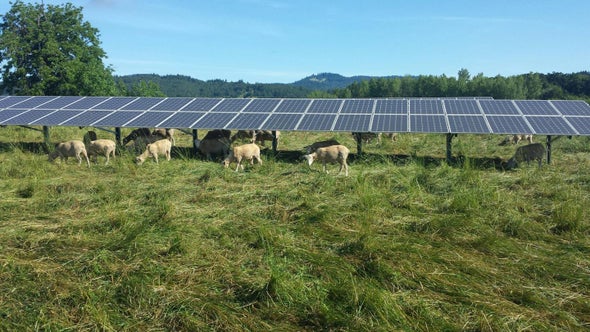(单词翻译:单击)
听力文本
This is Scientific American 60-second Science, I'm Susanne Bard.
We often associate giant solar arrays with deserts. But the extreme heat can curb solar panels' potential.
"It's like your laptop or your home computer. If it overheats, it slows down. So there's this tradeoff between having a lot, a lot of sun like in a desert, but if it gets too hot the efficiency of those panels drops."
Oregon State University ecological engineer Chad Higgins. His team is interested in where photovoltaic panels should be located in order to maximize energy production. In addition to moderate temperatures and sunlight, they found that conditions for the most efficiency include low relative humidity and gentle winds that enhance transfer of heat from the panels. By analyzing satellite data for these four factors, they created a map of potential solar panel productivity for different land types around the globe. Coming out on top? Agricultural croplands.
"And you think about it for a minute and it kind of makes sense. What is agriculture, but taking the sun's rays and converting it into a form of energy that we consume? So there's this sweet spot where you get a lot of sun but it's a temperate temperature and that is where you get the maximum productivity. And that's also where plants thrive."

Other factors also favor cropland solar.
"Agricultural lands tend to be closer to population centers where there is a market for electricity, rather than way off in the desert. Agricultural lands tend to be flat. They tend to be already disturbed. So you don't have as many ecological conservation worries."
Higgins' team thinks that agriculture and solar can complement each other, paving the way to a more sustainable energy future. The researchers estimate that installing photovoltaic panels on just one percent of croplands worldwide would be enough to meet all of humanity's global electricity needs. The study is in the journal Scientific Reports.
Higgins hopes the research will inspire collaborations between solar companies and farmers to feed the world and power it too. A prospect that should brighten anyone's day.
Thanks for listening for Scientific American — 60-Second Science. I'm Susanne Bard.
参考译文
这里是科学美国人——60秒科学系列,我是苏珊娜·巴德。
我们经常把巨大的太阳能电池阵与沙漠联系在一起。但酷热会抑制太阳能电池板的电位。
“就像你的笔记本或家用电脑一样。如果过热,运行速度就会变慢。沙漠中有大量阳光,但温度过高会导致太阳能板功率下降,因此需要在二者间找到平衡。”
俄勒冈州立大学的生态工程师查德·希金斯说到。他的团队想知道在哪里放置太阳能光伏板才能让发电量达到最大。他们发现,除了适中的温度和光照,产生最大效率的条件还包括相对较低的湿度以及和风,这些条件可以增强光伏板的热量传输。通过分析这四个因素的卫星数据,他们绘制了一张图表,说明全球不同土地类型的潜在太阳能板生产率。居于榜首的是哪种土地?农田。
“你思考一下,这是有道理的。什么属于农业,而且吸收阳光并将其转化为我们所消耗的能量形式?因此,这是既能获得大量阳光而且温度适中的最佳地点,也就是获得最高发电率的地方。这也是植物茁壮生长的地方。”
其他因素也有利于农田太阳能。
“农田往往更靠近人口中心,电力站通常设置在人口中心,而不是遥远的沙漠。农田趋于平坦。而且已被开发。所以没有那么多生态保护方面的问题。”
希金斯的团队认为,农业和太阳能可以互补,为更可持续的能源未来铺平道路。研究人员估计,仅在全球1%的农田上安装光伏板,就足以满足全球所有人口的电力需求。这项研究发表在《科学报告》期刊上。
希金斯希望这项研究能激发太阳能公司与农民之间的合作,为世界提供食物的同时也提供电力。这种前景应该能照亮每个人的生活。
谢谢大家收听科学美国人——60秒科学。我是苏珊娜·巴德。
译文为可可英语翻译,未经授权请勿转载!
重点讲解
重点讲解:
1. be interested in 感兴趣的;有兴趣的;关心的;
I thought she might be interested in Paula's proposal.
我觉得她对葆拉的提议可能会感兴趣。
2. in order to 为了;以便;目的在于;
Most schools are extremely unwilling to cut down on staff in order to cut costs.
大部分学校都很不愿意为减少开支而裁员。
3. convert into (使)改变;更改;(使)转变;
The signal will be converted into digital code.
信号会被转变为数字代码。
4. rather than 而非;胜于;而不是;
The zoo needed better management rather than more money.
这座动物园需要更好的管理,而不是更多的资金。


